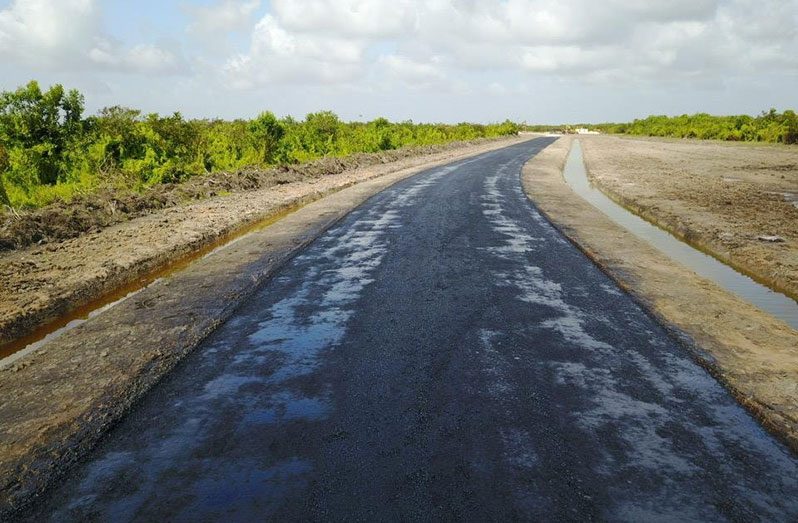WITH dozens of major infrastructural projects simultaneously taking shape nationwide, the government has already expended some $8 billion to improve the state of the country’s roads and bridges.
This represents just a fraction of the $25.6 billion that has been set aside for such improvements. More specifically, $6.8 billion has been spent on road works, while $1.2 billion has gone into constructing and rehabilitating bridges.
Minister within the Ministry of Public Works, Deodat Indar, told the Sunday Chronicle on Saturday that the ministry has been pushing aggressively to complete projects that are of proper quality.
Already, $1 billion has been spent on the Sheriff Street – Mandela Road Network and Expansion Project, which included the asphaltic paving of Sheriff Street from the Rupert Craig Highway to Durey Lane; the construction of a roundabout at the intersection of Sheriff and David Streets and the Railway Embankment; the widening and construction of drains on both sides of Sheriff Street and Mandela Avenue; the placing of a median which commenced at the intersection of Mandela Avenue and Homestretch Avenue, as well as preparatory works for the overlaying of asphaltic concrete on Sheriff Street and Mandela Avenue.
Meanwhile, works are moving apace on the East Coast to East Bank Demerara bypass road, which runs parallel with the East Bank Demerara Public Road, connecting Mandela Avenue to Diamond Housing Scheme.

Already, the section between Diamond and Mocha has been completed, while the section between Eccles and Mandela Avenue commenced during the first half of this year. Additionally, the Ministry of Housing and Water has moved ahead to issue bids for another section of the road project, which will link the East Bank Demerara communities of Eccles and Diamond.
Public Works Minister Juan Edghill had indicated that the persistent May/June rains, which resulted in massive floods throughout the country, has affected the deadline for multiple projects, including the Sheriff-Mandela expansion, which was scheduled to be completed by month’s end.
Another significant project is rehabilitation of the Soesdyke-Linden Highway, which, according to a mid-year financial report released by the Ministry of Finance, has benefitted from works totalling $90 million, while another $60 million is to be expended on completing the project during the second half of 2021.
Further, a number of dilapidated and damaged community roads were rehabilitated to the tune of $4.1 billion, which saw upgrades being done to approximately 53.2 km of roads during the first half of the year.
Separate from this, some $783 million was spent on constructing and repairing hinterland roads in regions One, Seven and Nine, the report said.
It was explained too that due to the unprecedented floods, there were notable delays in the commencement of most of the government’s “transformational road projects.” Notwithstanding the challenges, the report said that preparatory works have begun for the Schoonord, West Bank Demerara to Parika, East Bank Essequibo four-lane highway, as well as the Parika to Goshen route.
Minister Indar clarified that the funds spent on the aforementioned projects are part of the 2021 annual budget, and not the $10 billion supplementary funds, which were approved to respond to the devastating floods.
The minister indicated that of the $10 billion, significant sums were also spent on repairing important structures which were damaged by the floods.
Following an assessment done in June, Minister Edghill had estimated the cost to repair flood-damaged infrastructure as being within the billion-dollar range. He had said then that while the supplementary budget would not cover all the “rehab works” that needed to be done, the projects will be executed on a needs-basis.
Going forward, Edghill said that the floods highlighted the fragility of timber bridges and the need for more climate-resilient structures, especially to guard against flooding, Guyana’s most pronounced natural disaster.
More specifically, Edghill said that the government will be working to replace all of its wooden bridges and culverts with sturdy concrete structures. “We have to make up our minds. It is going to cost a lot, but we got to start building them in concrete,” Edghill said.
This was reaffirmed by President Dr. Irfaan Ali, during an event in Lethem, Region Nine (Upper Takutu-Upper Essequibo) on Friday.
The government’s mid-year report also pointed to the fact that reconstruction, and maintenance of bridges across the regions have since commenced, though hampered by delays due to higher-than-expected levels of rainfall. “Notwithstanding, these works are expected to be completed by the end of the year,” the report said.
It indicated too that the procurement process is ongoing for a new Demerara River Bridge crossing, with nine firms shortlisted and invited to tender. Further, the report said that the governments of Guyana and Suriname continue to forge ahead with their commitments to bridge the Corentyne River, with preparatory works already commencing for the project.




.png)









